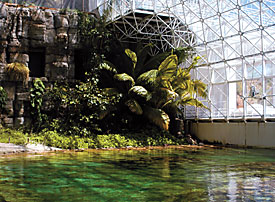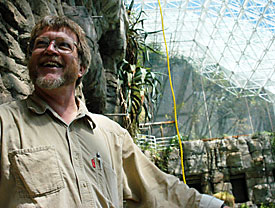 |
|
WILL SEBERGER/Arizona Daily Wildcat
|
Biosphere 2's man-made ocean was the test site for the Shadow III unmanned research vessel designed to study the giant pacific octopus. The ocean at Biosphere 2 is a 676,000 gallon reproduction of a Caribbean coral reef.
|
|
By Josh Sills
Arizona Daily Wildcat
Monday April 21, 2003
UA students and researchers have taken their research to new depths ÷ to the bottom of the ocean.
The result is a new device called "Shadow III" that will help scientists track giant pacific octopi in their natural habitat.
According to mechanical engineering professor Emeritus Tom Vincent, the device will sit on the ocean floor and photograph an octopus when it becomes active.
"Most of the time I think (Shadow III) will be at the bottom of the ocean," Vincent said "I think we'll get pictures of tentacles from it attacking (Shadow III)."
Shadow III will "know" to take pictures when sonar transmissions it emits are received by a device attached to the octopus, Vincent said.
 |
|
WILL SEBERGER/Arizona Daily Wildcat
|
Allen Wright, director of research operations, discusses the Shadow III research project at Biosphere 2 in Oracle, 35 miles north of Tucson.
|
|
To develop the tracking device, UA researchers and students worked in collaboration with the Colorado School of Mines and Alaska Pacific University.
The UA developed the computer controls and the balance system for Shadow III.
"Stability was a big question; we developed a ballast system to maintain buoyancy," Vincent said.
Vincent, along with Ananth Kini, a mechanical engineering graduate student, worked to update the computer system on board the device.
"The Shadow was running on an umbilical cord-type control," Vincent said.
That type of control, however, has been phased out, and Kini is now working to develop a better model.
"I'm basically involved in the transition from manual to automatic control," Kini said.
Representatives from all three schools met for the first time last month to test Shadow III at the "ocean" in Columbia University's Biosphere 2.
The Biosphere's ocean was a better arena for testing than the swimming pool the team previously used, Vincent said, because it allowed them to calibrate the instruments in a real world environment.
"They used our ocean because it's the only salt water in Arizona, and this ocean closely resembles the real thing," said Biosphere 2 Director of Research Operations Allen Wright said. "It is better though because it is controlled unlike in the real thing, where it might float away."
Wright said that Biosphere 2 is looking to promote itself for future research projects with UA as well as ASU and NAU.
"Biosphere is a great place for testing and research, because we can simulate real world condition and then control them. We can measure responses and change patterns."
Shadow III is currently in Colorado, where the sonar system is being refined. It will then move to Alaska to test it in the Pacific Ocean.
The device will be back at UA this fall, where Vincent and Kini will further refine it.

